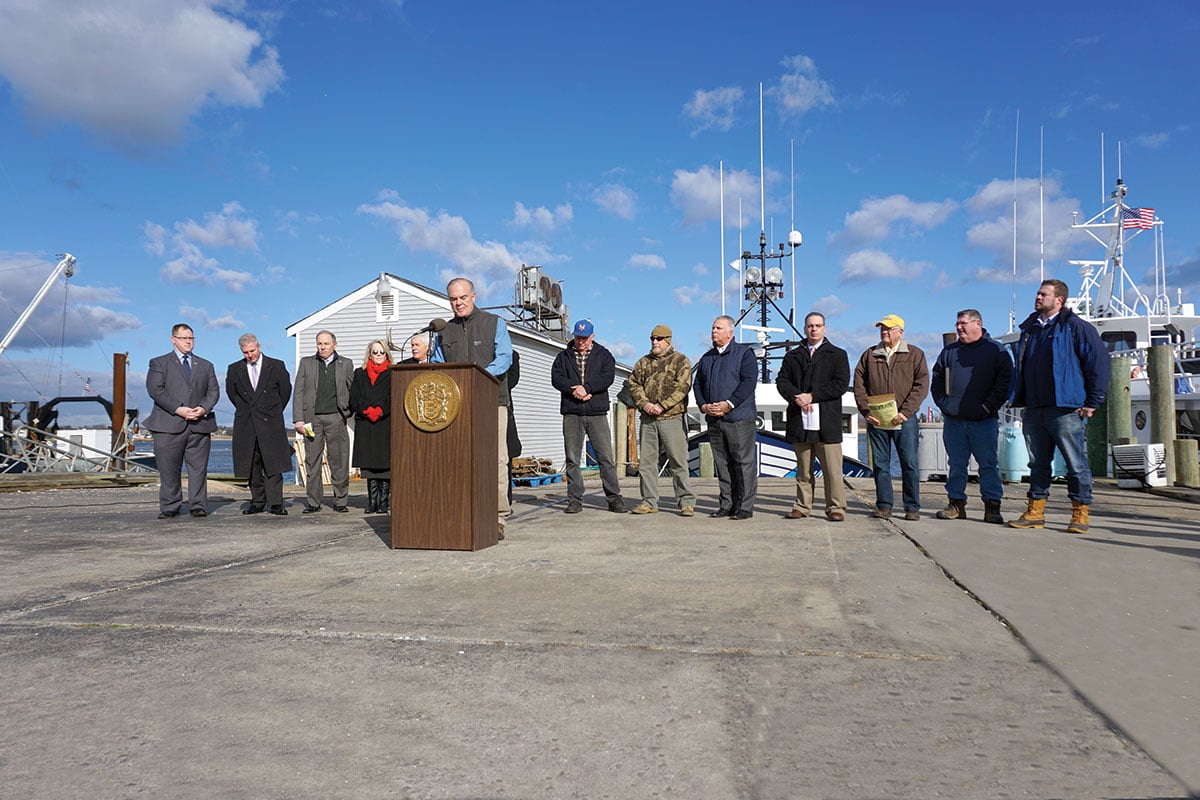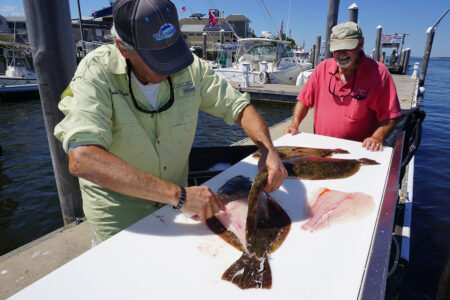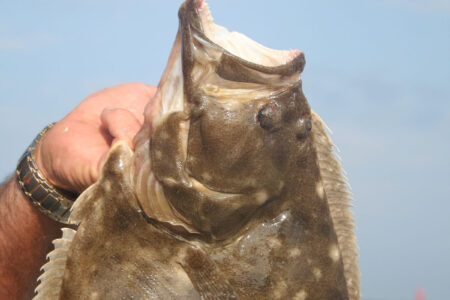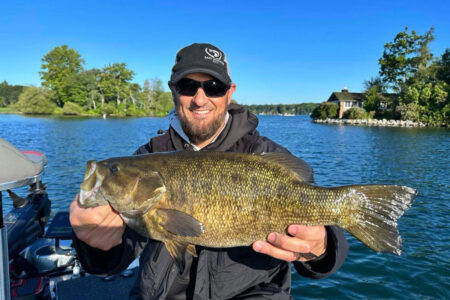
The 2017 summer flounder fracas spills over into March madness as New Jersey takes an “unprecedented” stand.
Apparently, the gloves are officially off.
On Thursday, February 2, New Jersey Department of Environmental (NJDEP) Commissioner Bob Martin traveled to Alexandria, VA to testify before the Atlantic States Marine Fisheries Commission (ASMFC) on behalf of Garden State fluke fishermen.
“If the Commissioners in this room do not choose to support postponing action or vote in favor of status quo the State of New Jersey will use every legal, administrative and political tool available to protect our recreational summer flounder industry from a decision that we believe will destroy that industry,” stated Commissioner Martin.
In what the Recreational Fishing Alliance (RFA) later called an “extraordinary move,” Commissioner Martin went on to tell ASMFC, “We will do everything possible to prevent the destruction of our $1.2 billion industry that directly employs over 20,000 people in our State and attracts tens of thousands of people to our coastal communities every year.”
As first reported at TheFisherman.com, ASMFC’s 7-3 vote in favor of so-called Option 5 of the Summer Flounder Draft Addendum XXVIII for 2017 fluke measures would apply a “near coastwide 1-inch size increase and bag limit reduction to four fish or less” along the Atlantic Coast, with North Carolina exempt from any changes and the tri-state region of New York, Connecticut and New Jersey cut back to three fish.
Because this option wasn’t actually approved by the ASMFC Technical Committee prior to the Virginia meeting – in fact, it fails to apply an 11% penalty for the recreational sector as required by NOAA Fisheries for alleged overharvest of 2016 harvest limits, for which North Carolina by example had none – it was unclear at the time of the vote if the option would really get approved.
For Commissioners looking to wheel and deal however, a 50/50 shot at getting the lesser restrictive of five options seemed somehow more reasonable than approving any of the other technically compliant options. Rhode Island and Massachusetts did try pushing for a three fish at 19-inch limit with 96 days of fishing for the New Jersey, Connecticut and New York region, but that motion also failed, leaving many states way wary of the threat of any “precautionary default measure” of two fish at 20 inches and a scant 62-day season from July 1 to August 31 applied to states not following the conservation equivalency guidelines.
For NJDEP commissioner Martin and the Christie Administration, the time for dealing with threat and compromise was pretty much over after the White House transition on January 20. The New Jersey delegation refused to join with the Option 5 supporters, choosing instead to take their argument to the new Secretary of Commerce, Wilbur Ross, who at the time of the ASMFC February meetings had still not been confirmed by the Senate.
“We Are Outraged”
“I strongly urge you to not move forward with changes to the size limits, bag limits, and the length of the season based on questionable data and an outdated model,” Martin told ASMFC members who had convened to discuss summer flounder measures, specifically asking for status quo measures or a postponement on any new fluke regulations until NOAA Fisheries received clearer authority under the new Trump administration. Soon after the ASMFC voted against that motion made by New Jersey’s legislative proxy to the ASMFC, Capt. Adam Nowalsky, the commissioner was on his way to Washington DC to press forward with the fight.
The New York delegation, led by ACMFC vice-chair and bureau chief of marine resources at the New York DEC Jim Gilmore, actually spearheaded the “Option 5” plan and refused to support the New Jersey fight; neither did Connecticut for that matter, despite being tied up in the same tri-state region (Delaware was the only other state to support New Jersey’s vote of defiance, a strong statement on their part.). That didn’t sit particularly well with the NJDEP.
“We are outraged by the summer flounder quota reductions approved today,” Commissioner Martin said while en route to the Rayburn House Office Building on Capitol Hill to address New Jersey’s Congressional delegation following the meeting. “Today’s actions will disproportionately impact New Jersey more than any other state along the coast.”
While Connecticut and New York would share in New Jersey’s draconian three fish at 19-inch bag limit and 128-day season, Rhode Island (19 inches and 245 days) and Massachusetts (17 inches and 125 days) would each have four fish bag limits, as would states from Delaware south to North Carolina fishing under 17-inch or lower size limits with 365 days of season. With the support of Governor Chris Christie, Martin and the state of New Jersey are now waging a directed campaign at the Trump Administration and members of Congress to fix what RFA called a “flawed and unworkable Magnuson Steven Act,” the nation’s primary federal fisheries law.
“The state of New Jersey has realized that they can’t help fishermen when their hands are tied by Magnuson and the Christie administration pledged to help us carry that message to the Trump White House,” said Jim Donofrio, RFA executive director, a longtime proponent of reforming the Magnuson Stevens Fisheries Conservation and Management Act.
“A well-crafted sustainable fisheries law should be exactly that,” said Nick Cicero, sales manager of the Folsom Corporation, a national manufacturer and distributor of fishing tackle well known to The Fisherman’s readers. “It must safeguard both the resource and accessibility to that healthy resource.”
“The Consequences”
The day before the ASMFC decision, Martin convened a conference call of New Jersey stakeholders including representatives from RFA, the Save the Summer Flounder Fishery Fund, Jersey Coast Anglers Association (JCAA) and the New Jersey Outdoor Alliance to present the state’s unwavering position on behalf of fluke fishermen.

JCAA’s Paul Haertel who participated in the call said afterwards, “We are steadfastly saying we are going to maintain status quo and we are not compromising.” Haertel went on to add “We need all of our groups and individual fishermen to support that position despite what the consequences might be.”
Those consequences, based on discussions during the ASMFC hearing on February 2, could include an emergency closure in New Jersey for both recreational and commercial fluke fishermen if the state ultimately defies any federal regulatory mandates, what hockey fans might refer to as a “game misconduct.” Donofrio however said New Jersey organizations are in support of Martin and the Christie administration, no matter the cost.
“We are confident that President Trump’s new administration is not going to let our fishing related jobs be destroyed by bad laws and broken fisheries management practices, especially not at the cost of denied public access to a sustainable natural resource,” Donofrio said.
Troubling of course to many New Jersey fishermen is the zealousness of the New York delegation to implement a regional management scheme for fluke in February of 2014, when that very same coastwide management body voted 7-4 to create a tri-state fluke region with Connecticut. One year prior in 2013, New Yorkers had been fishing on a 19-inch size limit and four fish bag limit, while New Jersey and Connecticut anglers fished a 17-1/2-inch size and five fish bag.
Three years later, many in New Jersey are wondering how much damage is actually being done to the fishery – both the fish and the fishermen – as regional size limits are back up into the nothing but female range and recruitment questions abound. And with New Jersey and Connecticut losing an inch-and-a-half of size, two fish and several weeks of season while New York settles back into essentially the same limit they had four years ago, it’s hard to discount Martin’s position on New Jersey being “disproportionately” impacted.
While hardline conservationists charge New Jersey with simply wanting to harvest more fish, the Christie administration’s position is actually based on getting new data together for a benchmark assessment, to scientifically establish if higher size limits in the recreational sector are actually contributing to lower recruitment, increased mortality and fluctuating harvest numbers.
For years, New York anglers railed against an unjust system, demanding to be treated more like those fishing across the border in New Jersey. In rejoicing the decision to lump three states together in 2014, New York reps cheered the regional approach as an opportunity for anglers and fisheries managers in all three states to join together and make rules that are fair for all. Strangely, when it came time to actually join together and unite in the fight for rules truly fair for all, New York – and Connecticut for that matter – didn’t really want to be like New Jersey after all.
U.S. Senators and House members have been talking about fairness and flexibility for nearly a decade; now with a new Trump administration, it’s the state of New Jersey with Governor Chris Christie with his NJDEP Commissioner taking the fight personally to Capitol Hill. Interested anglers will know more when the New Jersey Marine Fisheries Council meets on March 2 at the Stafford Township Municipal Building at 260 East Bay Avenue in Manahawkin.
So, with sticks and gloves strewn across center ice, New Jersey angling organizations, business owners and legislators have jumped into a full-scale donnybrook. Meanwhile, the teams from neighboring states have opted to sit it out on the bench, far away from the brawl. While there may in fact be future suspensions and penalty box time issued along the way, NJDEP Commissioner Martin himself probably said it best while buckling up his chin strap before the ASMFC meeting in Virginia as he told New Jersey’s fishermen, “enough is enough.”
For up to the minute news and information on the summer flounder fiasco, sign up for our email alerts and check regularly at TheFisherman.com.



